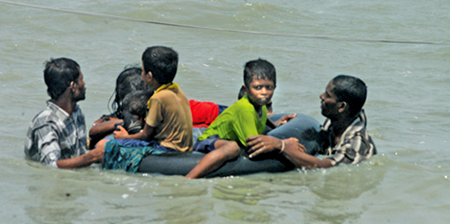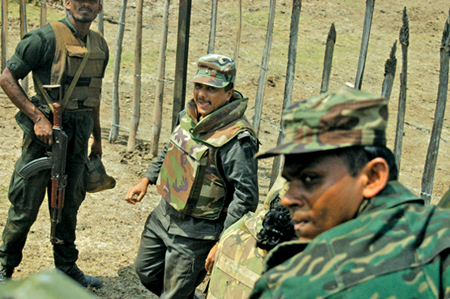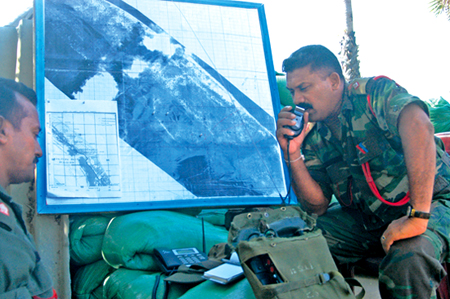Soldiers risked life and limb to save civilians
** UAV images to identify civilian movements
** Divisions launch special plans amidst
heavy fighting
Dhaneshi YATAWARA in Mullaitivu
|

The mammoth exodus of civilians - leaving behind the dreadful
past
Pix: Thilak Perera

Parents ferrying their treasures across to safety |
The images from the unmanned surveillance air craft of the Sri Lanka
Air Force - the UAV - sent on May 16 to the 59 Division were beyond
belief. An uncountable number of people was waiting about 200 metres
inland from the cause-way in the northern bank of the lagoon mouth.
It was only few hours before that troops of the 59 Division under the
command of Brigadier Prasanna de Silva cleared the cause-way connecting
the Nanthikadal lagoon along the A35 road, making a safety passage for
the people to reach the cleared areas. Troops of the 12 Sri Lanka Light
Infantry (SLLI) battalion commanded by Lieutenant Colonel Wasantha
Herath under the 593 Brigade commanded by Colonel Sujeewa Senerath Yapa
gained control of the cause-way.
The approximately 800 meters long cause-way was greatly damaged by
the LTTE. The satellite image maps clearly showed the damage. After
clearing the cause-way from land mines, troops repaired the entire
cause-way enabling mobility for the troops as well as to the escaping
civilians.
With the making of a safety passage for the people to escape from the
iron clutches of the LTTE, the Army started informing the civilians
using public announcing systems about the safe scape routes.
Blocking the path
By this time, troops spearheading the 12 SLLI defence line saw the
LTTE attempting to block the crowd. LTTE tried to stop the civilian
movement blocking the passage using two large trucks. LTTE cadres under
the cover of those trucks started firing at the civilians.
"Since there were civilians we couldn't fire in return. We shot in
the air and made people to lie down and be in safe position and then
snipped the main LTTE shooter. With this they turned one of the trucks
towards our defence line but suddenly the people started running towards
us passing the vehicle. The LTTE cadres couldn't do anything else other
than retreat," Lt. Col. Wasantha Herath said.
Thus, by around 3 O 'clock in the afternoon a huge influx of people
started pouring into the cleared areas.

Brigadier Prasanna de Silva in the foreground during civilian
evacuation mission |
Before the cause-way was cleared for the helpless Tamil people to
escape, Brigadier Prasanna de Silva instructed the Special Forces Divers
team to create a passage from the narrowest point of the two sides. By
this time the area was not cleared of LTTE threats. In a nighttime
mission the Special Forces (SF) Divers team was able to tie a strong
rope connecting the two sides. When the SF team reached the uncleared
area some LTTE cadres had noticed their presence. Being excellent
divers, the SF team managed to return successfully without being harmed.
Since the elderly, sick and wounded civilians faced a greater
difficulty to cross over the murky waters of the lagoon, the troops
began clearing the cause-way.
The next day, during its wee hours there was another mammoth crowd at
the end of the causeway seeking relief from the Sri Lanka Army.
Amidst heavy resistance from the LTTE the 59 Division received over
5000 IDPs on May 16. They were escaping towards Pudukkuduyirrippu.
Troops were facing a greater threat from possible suicide attacks to
breach the newly-formed Army defence lines. Identifying LTTE suicide
cadres entering into cleared areas was most difficult. They would
explode themselves if even a soldier begins to search them. The stress
was extremely heavy on the soldiers. The escape route was much easier
for these civilians who were moving towards Pudukkuduyirrippu compared
to those who escaped crossing the lagoon towards Mullaitivu.

Lieutenant Colonel Wasantha Herath during an operation to
capture the causeway |

Seniormost Commander in the Wanni Front, Major General
Jagath Dias inspecting a transit point |
But the threat to our troops was more, serious.To solve the problem
Major General Kamal Gunaratne, General Officer Commanding of 59
Division, instructed his officers to make arrangements to have a close
check on people and their belongings. Safety was the main concern.
Special care was taken for the elderly, sick and the disabled people.
The entire process ran on the untiring efforts of the soldiers.
Knowing the gravity of the humanitarian operation to save innocent
lives, Major General Kamal Gunaratne apportioned the responsibility of
caring for and securing the civilians among several battalions.
Depending on the numbers escaping each battalion had to ensure their
safety, provide them with food, water and medicine until they were sent
to Vavuniya for shelter at welfare centres.
In the 59 Division, Brigadier Prasanna de Silva instructed the 591
Brigade commanded by Colonel Aruna Ariyasinghe to take care of the
civilian rescue mission.
Rescuing people from the iron clutches of the Tigers is not just
bringing them to the other side of the land or making safety passages
for them to escape.
Vehicles to transport them needed to be arranged. Huge quantities of
food had to be provided for them in addition to the responsible task of
feeding thousands of officers and soldiers of the Army. Considerable
resources were needed and a continuous supply chain had to be
maintained, All these happened while intense fighting were continuing in
the Forward Defence Lines which resulted in heavy demand for arms and
ammunition, food, water, medicine, casualty evacuation etc.
Solid responsibility
Causing maximum attrition to the enemy was the prime task of Army. If
helpless Tamil people are at the risk of getting caught in the cross
fires, guaranteeing their lives became the Army's prime responsibility.
Soldiers risked their own lives in protecting the escapees until they
reached safety. This was the utmost sacrifice one could ever witness in
a battlefield!
In the raging battle between life and death, the human rescue mission
carried out by the Army could be a unique feat in the annals of military
history. |

